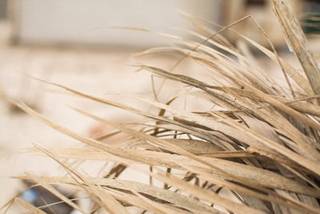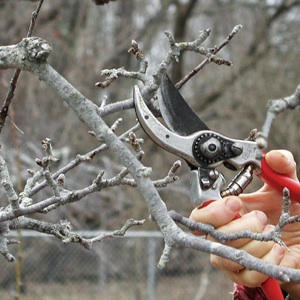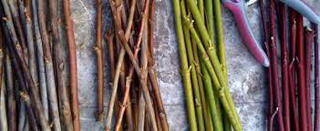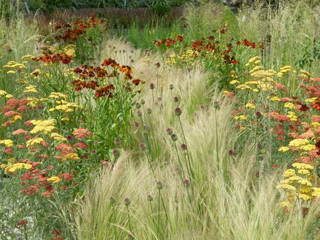
Well, we can’t believe it’s 2019. How on earth did that happen? Last time we looked, we were getting ready for the Saturday disco, dancing to power ballads, wearing our hair BIG and donning our shoulder pads. Still, you’re young as you feel, and we feel like whippersnappers
in this mild weather. You’d think, with a week or two away from the garden centre, we’d be making the most of it and wearing our best clothes, but no, wellies and mud-spattered clothes for us as usual.
It would be criminal not to get out for at least an hour outside each day for a poke around. We’ve been planting trees, building new raised beds and working out our planting plans for 2019. No, we never take a break from gardening or plants. Apart from the odd chilly morning, the weather has been clement enough recently that we’ve been able to get ahead with some tidying and pruning jobs as well.
So, what can you do, if you’re at least half as bonkers as we are?
Certainly clear away any dead or soggy herbaceous material, since it will look a whole lot tidier for minimal effort, and it’ll remove lots of hiding places for slugs. The more difficult you’ll make their winter, the fewer there will be to nibble your newly sprouting herbaceous in spring. Try to avoid cutting into stems on days when a cold following night is forecast, as this may endanger your plant, but if is it top growth that pulls away easily, leaving bare soil, that shouldn’t be a problem.
 That top growth is dead and serves no further purpose. Some people like to keep some dead growth for aesthetic (“structural”) reasons, but if it looks untidy to you, just compost it. Luckily, with the good weather we have had recently, a lot of the dead top growth has remained dry and brittle, which is a great carbon-filled addition to the composter. You need a good mix of green bits and carbon for good compost and it is not always easy to come by at certain times of the year.
That top growth is dead and serves no further purpose. Some people like to keep some dead growth for aesthetic (“structural”) reasons, but if it looks untidy to you, just compost it. Luckily, with the good weather we have had recently, a lot of the dead top growth has remained dry and brittle, which is a great carbon-filled addition to the composter. You need a good mix of green bits and carbon for good compost and it is not always easy to come by at certain times of the year.
Unless we have a sustained period of frosty nights (and if so, wait until it is less so) winter dormancy is also an ideal time to prune your apple and pear trees, and quince and medlar if you have any such unusuals. Gooseberries, autumn raspberries, grapevines and currants, it is their time as well. Essentially, anything with small pips, it is time to prune, and even continue to plant new bushes and trees, subject to the soil not being too cold or waterlogged. Anything with a stone (cherry, plum, gage etc), prune these after fruiting in late summer.
 The winter prune on apples, pears and such like is to encourage fruit production over new wood. The most productive wood is 1-4 years old, so if you have any very old branches, it is probably best to remove them entirely, 1/3 at a time, over the next few years. Very new growth should be taken back by a 1/3 to a bud, to encourage the production of fruiting spurs, the small knobbles where the flowers and fruit appear.
The winter prune on apples, pears and such like is to encourage fruit production over new wood. The most productive wood is 1-4 years old, so if you have any very old branches, it is probably best to remove them entirely, 1/3 at a time, over the next few years. Very new growth should be taken back by a 1/3 to a bud, to encourage the production of fruiting spurs, the small knobbles where the flowers and fruit appear.
Autumn raspberries are easy – just chop back to the ground and watch new shoots arise nearby the main plant. The main problem with raspberries, autumn or summer, is that they escape into areas where we may not really want them. Be vigilant, and dig up any looking to make a home where they shouldn’t, because they do run like billy-o, given the opportunity. These can be replanted where you do want them, to reinvigorate your stock, given away or potted up ready for donation to the local fete plant stall this summer. Remember, plants are for sharing.
And some of us are lucky enough to be able to grow grapevines outside too. Well, we grow a vine, and this dry warm summer saw us with many grapes to eat! Hurrah! So many in fact, we were roasting them in the oven on a fig-leaf base, which let me tell you, is fabulously aromatic and as easy as anything. Just line a baking dish with the leaves, put on the grapes, then sprinkle a little sugar, roast for 10-15 minutes, and het presto. A lovely easy pud.
 Anyway, we digress. A frost-free January day is an ideal time to prune vines, because they bleed if left much longer. The sap rises very early in vines and it will weaken the plant if it bleeds too much. Take off all but 2 to 3 buds’ worth of the previous year’s growth. These buds will form the basis of next year’s sappy growth, which will bear the fruit, and the previous year’s growth will slowly form a strong woody framework.
Anyway, we digress. A frost-free January day is an ideal time to prune vines, because they bleed if left much longer. The sap rises very early in vines and it will weaken the plant if it bleeds too much. Take off all but 2 to 3 buds’ worth of the previous year’s growth. These buds will form the basis of next year’s sappy growth, which will bear the fruit, and the previous year’s growth will slowly form a strong woody framework.
Winter is also a great time to take hardwood cuttings of deciduous shrubs and also root cuttings of fleshy-rooted herbaceous plants.
Taking hardwood cuttings relies on you having a bit of patience – deciduous viburnums, philadelphus, roses and cornus (dogwoods) all work well. However, it can take more than 6 months and often up to 12 months for any growth to emerge. So, if you can put those cuttings somewhere where you won’t worry at them for a long time, then do so. Be patient. Many a hardwood cutting has been lost by the impatient gardener tugging on it too soon and wrecking its chances of rooting.
Root cuttings are much easier. You just need a sharp knife and a seed tray full of compost, bury the root segments (about 1” long) and Bob’s your uncle. It’ll probably be too successful, if anything. Good candidates include achillea, Japanese anemone, eryngium (sea holly), nepeta (cat mint), acanthus (bear’s breeches) and papaver orientalis (the clump forming oriental poppy).
 Well, the decorations will be coming down soon, if they’re not already, the tree cast into some forgotten corner of the garden until all the needles drop off, and it is time to look forward to another year. It is sometimes hard to be positive when the days can be so grey, but have a poke around your garden, and even now, you will see the signs of new life.
Well, the decorations will be coming down soon, if they’re not already, the tree cast into some forgotten corner of the garden until all the needles drop off, and it is time to look forward to another year. It is sometimes hard to be positive when the days can be so grey, but have a poke around your garden, and even now, you will see the signs of new life.
Maybe the daphne is wafting its beautiful scent around, maybe the daffs and narcissus are straining their heads into the daylight, maybe the flower buds are on your camellias are getting noticeably fuller. Whatever you find in your garden, it is the sign that the cycle continues regardless of the tinsel, the gorging and the conspicuous consumption – it is what really matters, so take a few minutes every day to breathe it in and enjoy it.
Happy New Year, and may 2019 be another year you garden with joy.
Sarah Daniel and Helen Robins, Pengelly Garden Centre
www.pengellygardencentre.co.uk
on Facebook and instagram
